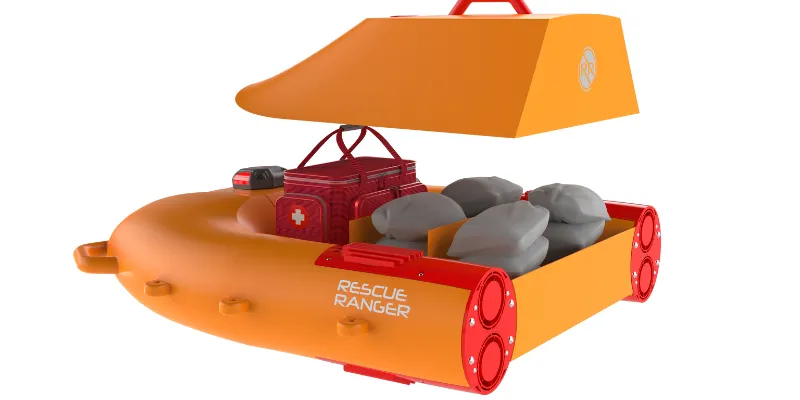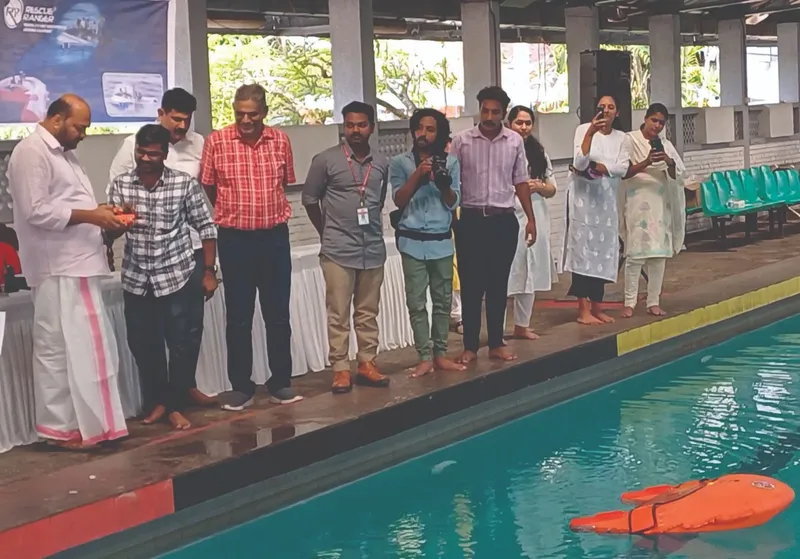How the 2018 Kerala floods led this duo to develop a multi-purpose device for rescue and relief
Anoop AB and Akhil P have invented Rescue Ranger, a multi-purpose life-saving device that can rescue people, recover corpses, map underwater terrain and provide relief during floods.
In August 2018, when Kerala experienced unusually heavy rainfall that led to death and destruction in the state, Anoop AB witnessed first-hand the horrific effects of a natural disaster.
As the president of the state drone operators’ association, he was called on by the government to help press drones into action for rescue and relief.

Rescue Ranger
Immediately responding to the call for help, and enlisting the services of the associations’ members and over 800 drones, Anoop was able to offer different kinds of assistance as the rain raged on for almost a week.
The harrowing visuals of the 2018 floods continued to haunt him long after the flood waters had receded and the state had limped back to normalcy.
This prompted him and his business partner Akhil P to start Dexter Innovation Technologies Pvt Ltd in Kochi – a startup that has developed an innovative device, Rescue Ranger that can rescue people during floods, detect corpses in water, map underwater terrain, and provide relief to those stranded or in distress.
Facing the floods
Anoop’s memories of 2018 are still vivid. It was chaos when he entered the scene.
“Emergency situations were out of hand. Dams were opened. There was a lack of coordination between different departments. It was flooding everywhere–in rivers, in the forest, and landslides were hampering rescuing operations,” he recalls.
After deploying drones, rescue operations began to gather momentum.
“We were able to drop off food packets, send ropes to connect people, rescue the stranded, and also help in flood mapping. We also helped bring in drones from Tamil Nadu for those stranded in Wayanad,” he adds.
The lessons of the 2018 floods were never forgotten. The self-taught developers and innovators, with no formal degree to their credit, began researching on how they could build a device that would combat every situation in a natural disaster that involves water.
“I kept remembering how people were saved with great difficulty. There were so many people stuck in landslides with no one to help. These images kept us going,” says Anoop.
Rescue and relief in diverse situations

The launch of the Rescue Ranger
The duo foresaw multiple situations that could happen. For this, they first designed a U-shaped buoy and attached four motors to it. Operated via remote control, this can be sent into the water and a person could hold on it and come back to shore. They named the product Rescue Ranger.
The next problem was the recovery of corpses during natural disasters.
“It takes a long time to recover bodies during a flood. We also discovered the kin were not receiving insurance because of non-recovery. We attached a sensor to the buoy that will record the temperature of a person to determine if he is dead or alive,” he explains.
The third addition facilitates mapping of underwater terrain.
“In Kerala, a lot of people go to the rivers and water bodies to swim. They are not aware of the depth or the current of the water, and a lot of them drown. The attached sensor can gauge the depth of a water body up to 40 metres and map the underwater terrain and give us the exact graph,” Anoop says.
This can be used to put up warning signs so that people can be cautious before they venture into the water.
During the 2018 floods, especially during the night, Anoop saw that communication was next to impossible between those stranded and the disaster management team.
A front-view camera, flashlight, and a walkie-talkie of up to 5 km range along with a siren attached to the Rescue Ranger can alert people and also the team on-ground. The underwater camera provides a 360-degree view that can transmit visuals.
The Rescue Ranger can also be fitted with a carry bag that can carry load up to 100 kg to transport food packets and medicines to flood-hit areas.
The multi-purpose life-saving device did not start off with a bang. Their first prototype with two motors didn’t work and the motor burnt out in their second one.
Looking for the right investors
This did not deter Anoop or Akhil. But a severe lack of funds was affecting them. They had received Rs 5 lakh as a loan from a government agency, and they had added Rs 10 lakh from their own savings, but it ran out soon.
This stalled the project for almost four years, until the beginning of this year, when they received a bank loan of Rs 10 lakh with the help of the Ministry of Industry, Government of Kerala. In just three months, the first Rescue Ranger was ready. Tested at Pazhassi Reservoir in Kannur, the device was finally launched by P Rajeev, Minister for Law, Industries & Coir, in Kochi. The company is registered with Startup India and the Kerala Startup Mission.
Funding remains the major stumbling block for the duo to start the production of Rescue Ranger in full swing.
“We are in talks with the government and hope it materialises soon. It will take just two months to start production once we receive funding,” Anoop says. He admits that the lack of a formal degree and networking skills have been an impediment in receiving grants or funds.
“Most investors would want us to follow a structured process or timeline, and we are unable to work like that. We are passionate about what we do, and committed to the cause,” he adds.
Meanwhile, they have been receiving a lot of enquiries about Rescue Rangers from people in India and abroad.
People have different requirements, says Anoop. These could include simple attachment for a ferry boat, terrain mapping and rescue features for the fire and safety department, all functions for the disaster management team or one with a basic feature for houseboats. However, he emphasises that the disaster management, fire safety teams, and government agencies will be given first preference during production, and Rescue Rangers will be supplied to others later.
The price of a Rescue Ranger starts at Rs 4 lakh and can go up to Rs 17 lakh depending on attachments and customisation.
Edited by Megha Reddy






